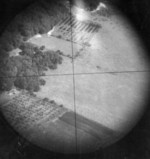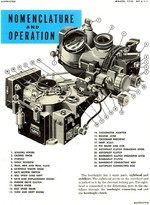Norden Bombsight
| Country of Origin | United States |
| Type | Bombsight |
Contributor: Alan Chanter
ww2dbaseThe origins of the Norden bombsight can be traced back to 1921, when the US Navy asked consulting engineer Carl L. Norden, a Dutch-born authority on gyroscopes, to devise a gyro–stabilized base for their existing Mark 3 bombsight so that it could be used from high altitude. The device that Norden created worked perfectly well as long as the target was stationary. Unfortunately, enemy ships are rarely obliging enough to remain at anchor when attacked. The Navy therefore requested a more refined bombsight still. One that could be used against moving targets. This was a more complicated problem than just providing a stabilizer for an existing sight. Norden enlisted the assistance of engineer Theodore Harold Barth and Lieutenant Commander Frederick I. Entwhistle, an officer from the US Navy Bureau of Ordnance. Together they set to work to develop an improvement to Norden's earlier device.The Mark 11 gyro-optical sight they developed in 1924 incorporated a unique timing device to indicate the correct moment for bomb release. But this was just the beginning, and the Mark 11 sight was not ready for testing at the Naval Proving Ground, Dahlgren, Virginia, United States until 1928. Installed in a Martin bomber, a navy pilot, Lieutenant John J. Ballentine was detailed to make the first practice drop. Unfortunately, no allowance had been made for the very low temperatures experienced at high altitude, and on the day of the trial it was particularly cold. When Ballantine commenced his run he discovered that the device was completely frozen up. Not wanting to disappoint Carl Norden, who was watching from the ground, Ballentine made the drop, with excellent results, by rule of thumb! Ballentine landed and climbed cheerfully from the bomber, only to be met by a downcast Carl Norden exclaiming "Bally, you don't have to tell me. The sight didn't work. You dropped those bombs by eye!" Norden, however, would not admit defeat and soon overcame the inevitable teething problems in a new piece of complicated equipment. In 1929 an improved Mark 11 sight was yielding 50 per cent better results than the old Mark 3…the Navy ordered eighty examples.
Despite the accuracy attainable with the Mark 11 the Navy was not happy with the complexity of the instrument and expressed doubts about its operational effectiveness. The timing device required the aircraft's speed during a bomb run to be established at a substantial distance from the target and accurately maintained throughout a long approach making the bomber a sitting duck for defending fighters and anti-aircraft guns. To be effective the pilot would need to skillfully keep the plane absolutely level and at a constant speed.
Carl Norden went back to work. A new company - Carl J. Norden Inc. was established in New York, New York, United States in 1928. By 1931 another new bombsight was ready – the famous Mark 15. With this instrument the closing speed of the attack could be established at any time during the run-up and although a long steady approach was still necessary, a fixed speed and altitude had only to be maintained for 15 or 20 seconds. The Mark 15 was tested against the hulk of the old heavy cruiser Pittsburgh in 1931 and the results were so impressive that the US Army placed a purchase order on top of what the Navy required.
To ensure the smoothest possible flying conditions on a bombing run, Norden devised a gyro-stabilized automatic pilot, known as the Stabilized Bombing Approach Equipment (SBAE) to the Navy and Automatic Flight Control Equipment (AFCE) to the Army. This made it possible for any military aircrew to bomb with an accuracy that previously only the specialist at the Naval proving ground had been able to achieve. From four miles above the dry lake at Muroc, California, United States, Army fliers found that they could consistently drop their bombs within 50 feet of a practice target. These feats became enthusiastically referred to as "pickle-barrel" accuracy, based upon American bomber crews boasting that they could put a bomb into a pickle-barrel from 20,000 feet.
In its final form the Norden bombsight weighed 45 pounds and incorporated over 2,000 components. The stabilizer consisted of two electric gyros, one of which was set up to detect deviation from the aircraft's set course (the directional gyro), whilst the other registered any tendency to either roll or to nose-up or nose-down (the flight gyro). The sight was mounted on top of the stabilizer and was fitted with a 2.5 power telescope driven by a variable speed electric motor; a computer consisting of innumerable cam gears, prisms, lenses and mirrors; and a gyro to hold the sight stable. Norden's New York factory initially had an output of 800 units per month but after the Japanese attack on Pearl Harbor production was stepped up with additional manufacturing outsourced to suitable civilian factories. By the end of 1943 output had reached almost 2,000 sights per month.
Before the Norden could be used the bombardier needed to feed basic data into the computer. From pre-calculated tables he would get the time that the bombs would take to fall based on the aircraft's speed and altitude. As the target came into view the autopilot would cut in to control, through servo motors, the ailerons and rudder. The bombardier had a certain amount of manual control to take evasive action in heavy flak, but once the final run-in commenced the stabilizers would keep the plane on track. The complex computer made it possible to allow for drift affecting the plane, as well as influencing the bombs during their fall. This made hitting moving targets as easy as stationary ones. The only fault with the Norden was that it could not be used from under 1,800 feet which made it of limited value to the Navy. When production got under way in 1940 priority was given to supplying the Army's heavy and medium bombers for employment largely in the European theatre of war. The Navy's usage being confined mainly to equipping patrol planes. While US bombing accuracy was much improved with the Norden bombsight, which was known to aircrew as the "Blue Ox", it could not always overcome heavy cloud or the sub-zero temperatures from four miles high encountered over Northwest Europe. During 1943-44 the 8th Air Force based in England regularly found it better to follow radar equipped pathfinders to the designated target. Likewise, the device could be adversely affected by the tropical heat and buffeting winds found in China.
Strict security was always maintained over the Mark 15 bombsights. They were never allowed to be left unattended in aircraft and after every mission would be removed for storage in secure guarded bunkers. When required again they were carried to the aircraft by two armed servicemen; their canvas covers not being removed until the plane was actually airborne. Despite such security precautions Norden sights wee inevitably captured by the Germans and Japanese. Early in the Pacific war a special US Navy recovery team was sent to recover a Mark 15 set from a Catalina flying boat that had sunk in a coral atoll south of the Territory of Hawaii. With grappling hooks the wreck was hauled to the surface; the bombsight systematically smashed and the wreckage returned to the sea bed. However, by the end of 1943 the Americans were losing up to 60 bombers on a single mission, and naturally some of these were carrying Norden bombsights. The complexity of the Norden was such that American experts believed that it would take the Germans two years to unravel its mysteries and set up production facilities to produce a copy. Actually the Luftwaffe never developed a long-range high-altitude strategic force and therefore had no need of a sight like the Norden.
Source:
Gary Craig: "Norden Bombsight" (War Monthly) ww2dbase
Last Major Revision: Mar 2020
Photographs
 |  |  |  |
Please consider supporting us on Patreon. Even $1 per month will go a long way! Thank you. Please help us spread the word: Stay updated with WW2DB: |
Search WW2DB
News
- » US Women's Army Corps "Six Triple Eight" Awarded with Congressional Gold Medal (30 Apr 2025)
- » Wreck of Soviet Submarine M-49 Found (10 Apr 2025)
- » Japanese Emperor Visited Iwoto (Iwo Jima) (8 Apr 2025)
- » Race, Holocaust, and African-American WW2 Histories Removed from the US Naval Academy Library (7 Apr 2025)
- » US Government Plans to Purge WW2 Information (17 Mar 2025)
- » See all news
Current Site Statistics
- » 1,167 biographies
- » 337 events
- » 44,617 timeline entries
- » 1,244 ships
- » 350 aircraft models
- » 207 vehicle models
- » 376 weapon models
- » 123 historical documents
- » 261 facilities
- » 470 book reviews
- » 28,514 photos
- » 365 maps
Famous WW2 Quote
"Since peace is now beyond hope, we can but fight to the end."Chiang Kaishek, 31 Jul 1937
Support Us
Please consider supporting us on Patreon. Even $1 a month will go a long way. Thank you!
Or, please support us by purchasing some WW2DB merchandise at TeeSpring, Thank you!